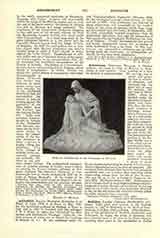

Achtermann, THEODORE WILLIAM, a German sculptor, was born in 1799, at Munster in Westphalia, of poor parents. After working on a farm he became a cabinet-maker. His carving was so clever and graceful that it attracted attention, and procured him the good will of some art patrons, who sent him to Berlin (1831), where he studied under the direction of Rauch, Tieck, and Schadow, then the foremost sculptors of Germany. Achtermann, however, being of a profoundly religious character, was drawn irresistibly to Rome, where he arrived in 1839 and remained till the end of his life. The first prominent product of his Roman studies was a Pieta which was secured for the Cathedral of Munster and which has often been copied. In 1858 the same cathedral acquired a group of seven lifesize figures representing the descent from the Cross which is regarded as one of its chief art treasures. His last great work, finished when the artist had passed his seventieth year, was a Gothic altar with three reliefs representing scenes from the life of Our Savior. This was set up in the cathedral at Prague in the year 1873. He died at Rome in 1884. Achtermann’s art is characterized by deep religious feeling and great imaginative power, though, on account of his having taken to an artistic career when somewhat advanced in life, he did not attain the technical mastery which he might otherwise have acquired.
CHARLES G. HERBERMANN

